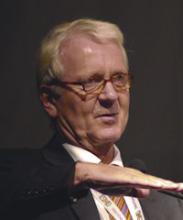MILAN – Figitumumab was active against refractory Ewing’s sarcoma in heavily pretreated adolescents who were enrolled in a phase I/II study.
Treatment with Pfizer Inc.’s investigational agent was associated with an overall response rate of 14.2%, a median progression-free survival of 1.87 months, and a median overall survival 8.87 months.
“This is another weapon in the fight against Ewing’s sarcoma,” study investigator Dr. Heribert Jürgens said at the annual congress of the European Society of Medical Oncology.
“It’s a miracle to see a patient who has received first-, second-, third-, fourth-line chemotherapy suddenly respond,” said Dr. Jürgens of the department of pediatric hematology and oncology at the University Children’s Hospital Münster (Germany).
Figitumumab is a fully human anti-IgG2 monoclonal antibody that acts by blocking, internalizing, and degrading the insulin-like growth factor type I receptor (IGF-IR). IGF-IR is an attractive therapeutic target in pediatric sarcomas; not only does it play a key role in cancer cell survival, but its levels tend to peak around puberty when growth hormone levels are high.
The drug is one of several IGF-IR monoclonal antibodies currently being investigated in sarcoma and other solid tumors; these include Amgen Inc.’s AMG 479, ImClone Systems Inc.’s IMC-A12, and Schering-Plough’s SCH-717454 and robatumumab.
To date, however, the results with figitumumab in other tumor types have been disappointing, with phase III trial data that was presented at the American Society of Clinical Oncology not showing a benefit of adding the drug to standard chemotherapy (carboplatin and paclitaxel) in non–small cell lung cancer, despite initially promising phase II results (J. Clin. Oncol. 2010;28[15s]:abstract 7500).
The preliminary findings reported by Dr. Jürgens involved 138 patients aged 10-18 years with Ewing’s sarcoma, osteosarcoma, or other rare sarcomas for whom no curative therapies were available. The median age of patients was 16 years among 31 youngsters in phase I, and 18 years among 107 in phase II. The patient population was almost two-thirds male. Figitumumab was given every 4 weeks at a dose of 20 or 30 mg/kg in phase I and 30 mg/kg in phase II.
No dose-limiting toxicities were reported in phase I of the trial, with “acceptable tolerability” seen in the phase II part. Grade 4 adverse events attributed to figitumumab in phase II included one case each of decreased appetite and leukemia, with the most commonly reported grade 3 adverse events being hyperglycemia (2.8%), transaminase increases (1.9%), and neutropenia (1.9%).
The primary end point in phase II was the overall response rate, which could be evaluated in 106 patients. It comprised 15 partial responses, given an ORR of 14.2%. The median duration of response was 4.7 months, ranging from 3.5 to 11.7 months with two patients still ongoing.
Dr. Jürgens reported that progression-free survival was significantly longer in patients with free IGF-I serum levels of 0.65 ng/mL or higher vs. those with less than 0.65 ng/mL before treatment (10.41 vs. 3.65 months; P less than .001). Similar results were observed for total IGF-I levels, with patients doing better with higher (at least 10 ng/mL) than with lower (less than 110 ng/mL) levels. “The potential association of pretreatment IGF-I serum levels with survival benefit warrants further investigation,” Dr. Jürgens said.
“There are some interesting responses in Ewing’s sarcoma,” commented the invited discussant, Dr. Hans Gelderblom, a medical oncologist at Leiden (the Netherlands) University Medical Center. He noted that responses to IGF-IR monoclonal antibodies tend to be short lived, however, and suggested that the way forward might be to combine these agents with other therapies.
Pfizer sponsored the study. Dr. Jürgens and coauthors have received research funds from the company, and two of the authors are employees. Dr. Gelderblom has received payment for attending Pfizer advisory board meetings.


